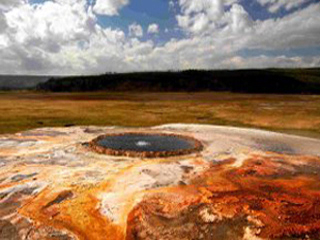
A microbial community growing in the runoff of a hot spring in Yellowstone National Park. The interplay of microbial growth and the flow of water produces brilliant patterns. (Image courtesy of Kate Harris. Used with permission.)
Instructor(s)
Prof. Daniel Rothman
MIT Course Number
12.086 / 12.586
As Taught In
Fall 2014
Level
Undergraduate / Graduate
Course Description
Course Features
Course Description
This course provides an introduction to the study of environmental phenomena that exhibit both organized structure and wide variability—i.e., complexity. Through focused study of a variety of physical, biological, and chemical problems in conjunction with theoretical models, we learn a series of lessons with wide applicability to understanding the structure and organization of the natural world. Students also learn how to construct minimal mathematical, physical, and computational models that provide informative answers to precise questions.
This course is appropriate for advanced undergraduates. Beginning graduate students are encouraged to register for 12.586 (graduate version of 12.086). Students taking the graduate version complete different assignments.
Other Versions
Other OCW Versions
Archived versions: ![]()


